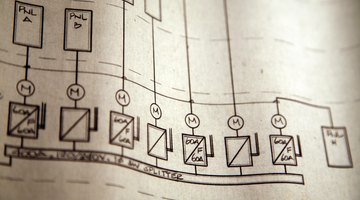How to Draw an Electrical Floor Plan With Circuits
Drawing accurate, detailed electrical floor plans is one of the essential steps in applying for an electrical-wiring permit. Standard symbols indicate the location of duplex outlets, special-purpose outlets, switches, wall-light outlets, ceiling-light outlets, and switches on electrical floor plans.

ANSI (American National Standard Institute) symbols are industry standards and recognized by the AHJ (Authority Having Jurisdiction), electrical inspectors, and building department engineers who issue electrical permits. The symbols are easy to remember but keep a copy of them nearby to avoid errors.
Things You Will Need
- NEC (National Electric Code) NFPA (National Fire Protection Association) Publication 70, 2008 Revision
- ANSI Electrical Symbols
- ¼-inch grid graph paper
-
Draw a floor plan to scale. A scale of ¼ inch to the foot is a convenient scale to work with. Using that scale, most homes will fit on a sheet of 11-inch by 17-inch graph paper.
-
Indicate the locations of all general-purpose duplex receptacles in rooms and hallways. Review NEC Article 210.52 Dwelling Unit Receptacle Outlets for more information. In summary, no point measured along the unbroken floor line can be more then 6 feet from a receptacle outlet, keeping in mind that a duplex outlet counts as two outlets. Any wall space 2 feet in width or wider must have a receptacle outlet. Any hallway 10 feet or longer must have at least one receptacle outlet. Place the first receptacle 6 feet from the first break in floor line, then place the rest at 12-foot intervals. One duplex receptacle fulfills the rule for a span of 6 feet to each side of its location.
-
Draw in the positions of all wall- and ceiling-light outlets.
-
Draw in the positions of all wall-mounted switches.
-
Show the position of all the special-purpose receptacles--those for an electric range, clothes dryer, garbage disposal, dishwasher, trash compactor, refrigerator, and deep freezer, for example.
-
Lay out the position of the kitchen countertop small-appliance circuits so no space 2 feet or more in width is without a receptacle outlet and every wall space 12 inches or more in width has a receptacle outlet per NEC Article 210.52(C)(1).
-
Indicate the position of the circuit-breaker panel on the drawing.
-
Use solid, curved lines to indicate branch-circuit wiring concealed in walls and ceilings; broken lines with long and short dashes to indicate branch-circuit wiring concealed in floors; and dotted lines to indicate branch-circuit wiring that's exposed.
-
Use solid lines with solid arrowheads pointing toward the circuit-breaker panel to indicate "Homeruns," the cable bringing power from the service panel to the first device on that circuit.
-
Use short slashes drawn across these lines to indicate the number of circuit conductors in each cable run.
Tip
There are symbols for doorbells, doorbell transformers, doorbell buttons, telephone outlets, intercoms, and anything else that you might want to incorporate in your plan so you need to download and print out the full set of ANSI Electrical Symbols from the reference site given.
The Drip Cap
- Drawing accurate, detailed electrical floor plans is one of the essential steps in applying for an electrical-wiring permit.
- Standard symbols indicate the location of duplex outlets, special-purpose outlets, switches, wall-light outlets, ceiling-light outlets, and switches on electrical floor plans.
- Any wall space 2 feet in width or wider must have a receptacle outlet.
- Draw in the positions of all wall-mounted switches.
- Use short slashes drawn across these lines to indicate the number of circuit conductors in each cable run.
References
Resources
Writer Bio
Based in Colorado Springs, Colo., Jerry Walch has been writing articles for the DIY market since 1974. His work has appeared in “Family Handyman” magazine, “Popular Science,” "Popular Mechanics," “Handy” and other publications. Walch spent 40 years working in the electrical trades and holds an Associate of Applied Science in applied electrical engineering technology from Alvin Junior College.
Photo Credits
- Jupiterimages/Photos.com/Getty Images
- Jupiterimages/Photos.com/Getty Images
More Articles



